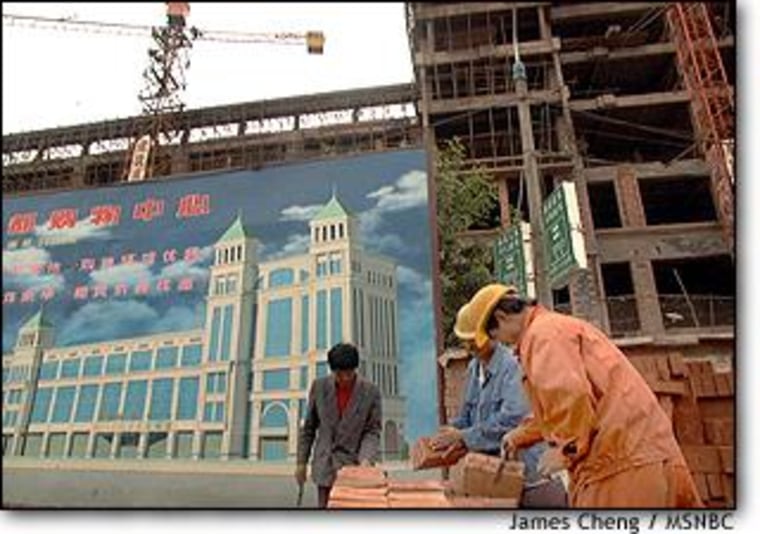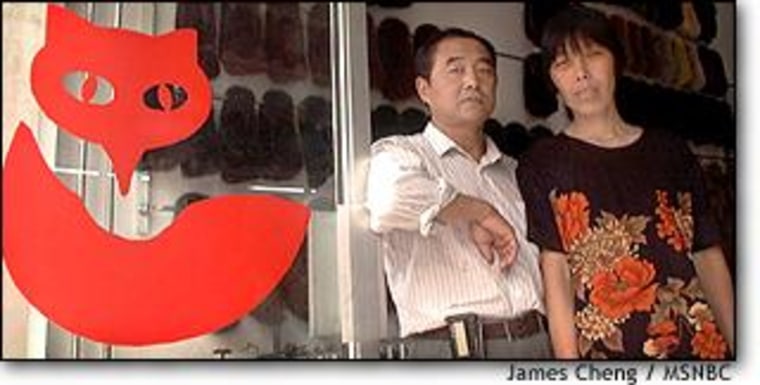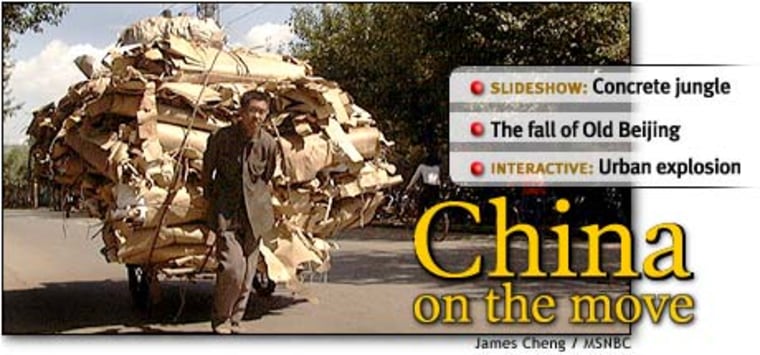Rising out of the Jizhong Plain 200 miles south of Beijing is the kind of population boom that Chinese policymakers like to see. From a rural county town of 35,000 in 1986, Xinji has exploded into a concrete jungle, home to 620,000 people.
Xinji is a sort of Akron, Ohio, of northern China - serving as a tannery and chemical-industry base for the region. It’s hardly glamorous, but for many former peasants, it’s better than staying on the farm, where paltry lots are carved smaller with each successive generation. And for the government, encouraging growth in cities like Xinji is a way to avert a flood of peasants into the already overburdened coastal cities.
Nowhere in the world is the threat of urban overcrowding greater than in China, which now has a population of 1.2 billion. For decades, at least 80 percent of China’s population was forced to remain in the countryside under a well-enforced registration system that limited movement.

Since those controls were eased in the 1980s, more than 100 million people have joined the “floating population,” most of them rural dwellers migrating to cities in search of jobs. The country already has 14 cities with at least 3 million residents. Even so, Beijing’s careful use of economic policy has largely averted the blight of shantytowns that has marked other developing countries.
“I think they’re very lucky not to have more than 100 million rural migrants since there’s not much enforcement of the registration system,” says Nicholas Driver, managing director of Beijing-based consultancy Clear Thinking, which specializes in agricultural issues. “Really, the only way they can regulate it is through the market.”
Down from the farm
Shi Zhonghe represents the perfect demographic shift, from Beijing’s point of view. Several years ago, the farmer had a vision of the future for his three children, and it was grim. They would have had to divide the tiny family plot, making it difficult or impossible for any of them to prosper. Under central government policies issued in the late 1970s and early 1980s, farmers were allowed to start sideline businesses to break the back of this grinding poverty. In 1989, Shi started a fox-fur business.
Then Beijing started handing down directives to the provinces and local governments to turn certain towns into “cities.” The new designation provided for some funding from Beijing, while provincial and local governments covered most of the cost for new roads and power lines. They were also to lift restrictions on peasants who want residency in these new cities.

Even though Beijing actually provided only a nominal portion of the funding, it was in the local governments’ interests to push for urbanization. “They generate more taxes from enterprises than they do from peasants,” says Driver. “And having cities is definitely prestigious.”
Xinji, which was named a “city” in 1986, now boasts of employing 50 urban planners mapping out housing development and services. About a third of Xinji’s total population now lives in the honeycombed city center, while the rest live in separate homes and semirural conditions.
In 1991, the government poured some $75 million into the construction of “Leather City,” a wholesale and retail market. Shi is among the 1,000-plus merchants who purchased a mall-level shop and moved with his family into the rooms above. He also hired two other young men to work in his shop, which makes the furs into collars and accessories.
Bleak landscape
There is little to see in Xinji, other than Leather City, with its racks of winter coats and faux Chanel bags. Vast stretches of housing blocks are punctuated by wide empty avenues and dusty construction sites. Xinji also has large tanneries, chemical plants and pesticide producers, some moved from larger cities trying to rid themselves of pollution.
But Shi says living in Leather City is better than life back on the farm, which is now tended by his elderly parents. His income is higher- ranging from $4,000 to $8,000 a year, compared to an average rural income of about $250. He harbors few dreams of the big city.
“Why would I go to Shanghai?” says Shi. “The buyers come here from Shanghai and all over. And expenses are high ... so it’s not clear we would make more money anyway.”
The move to raise living standards and urbanize rural China arguably has changed China more than the new skyscrapers of Shanghai, the discos of Guangzhou or the return of Hong Kong. According to government figures, more than 200 cities of about half a million residents have been built in the 1990s.
In their effort to set themselves apart from the masses, many cities have branded themselves as the “capital” of a certain product, such as beer, silk, cashmere or melons. Others have set up wholesale markets or industrial parks to attract traders and investors.
China’s little-known medium-size cities are dwarfed by Beijing (population: 11.3 million) and Shanghai (population: 14.5 million), but they have played an important economic and social role. According to China’s State Statistical Bureau, nearly 30 percent of the Chinese people are now city dwellers, compared to less than 20 percent when reforms began two decades ago.
Growing pains
The process has its flaws. Some environmentalists say that these new cities are gobbling up precious farmland at an alarming rate, so Beijing has been forced to craft new rules to control the sprawl. Some rural towns have flourished into cities in ways that Beijing has a hard time controlling, like the town of Baigou, also in Hebei province and best known for illegal sales of weapons, pornography and pirated goods (including counterfeit AK-47s).

And keeping up with the growth in major cities is still a battle. Shanghai is rebuilding its infrastructure after decades of decay. But its water system is still severely stretched and its new highways are overloaded even as they open.
Indeed, there is a growing hostility to rural arrivals among the urban elite of Beijing and Shanghai, who blame the “tubaozi” (“dirt balls”) for rising crime and disease. Transients typically cannot get access to educational or medical facilities in coastal cities. And in Beijing, the hub of government and culture, authorities launch arbitrary crackdowns on rural transients, thought to number nearly 3 million. Recently, there has been an ongoing “cleanup” of vendors and beggars to create a good impression for President Bill Clinton’s arrival.
“There is still a debate about how many migrants are good,” says Driver. “Some economists say movement should be completely free - keeping average wages and cost of business down to grow the economy. But most urbanites do not agree because it keeps their wages down too.” With at least 800 million people still living in relatively poor rural conditions, China’s policy makers will be grappling with the problem for a long time to come.
